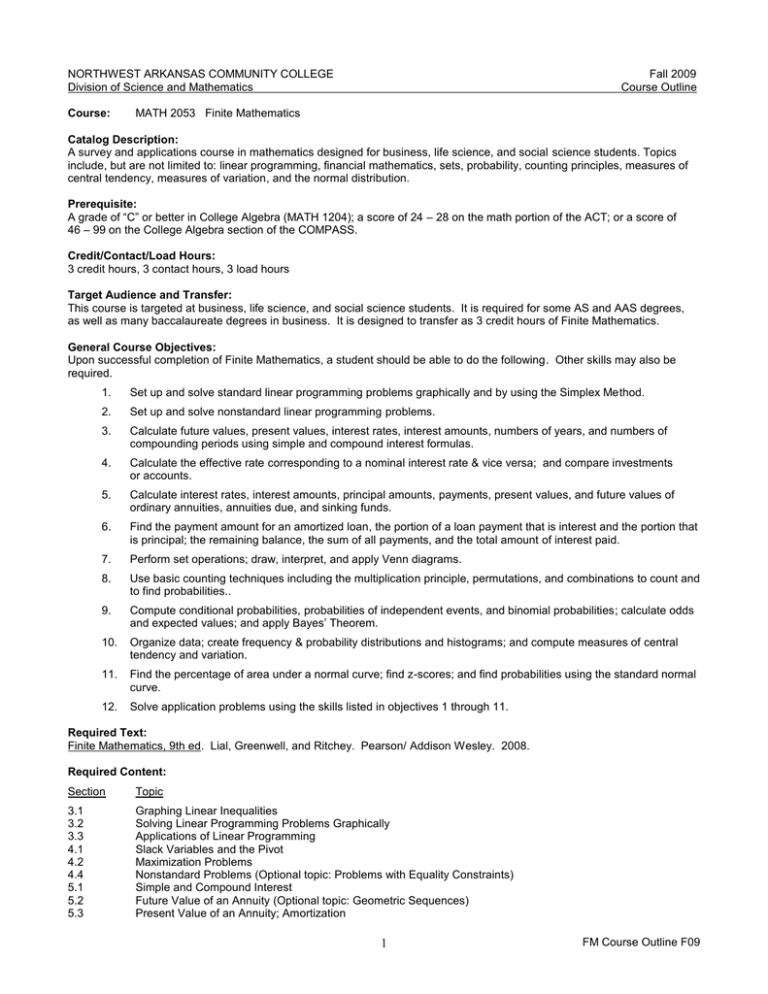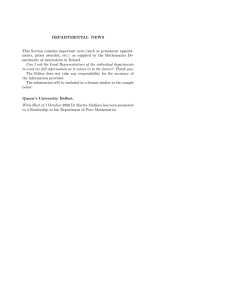
NORTHWEST ARKANSAS COMMUNITY COLLEGE
Division of Science and Mathematics
Course:
Fall 2009
Course Outline
MATH 2053 Finite Mathematics
Catalog Description:
A survey and applications course in mathematics designed for business, life science, and social science students. Topics
include, but are not limited to: linear programming, financial mathematics, sets, probability, counting principles, measures of
central tendency, measures of variation, and the normal distribution.
Prerequisite:
A grade of “C” or better in College Algebra (MATH 1204); a score of 24 – 28 on the math portion of the ACT; or a score of
46 – 99 on the College Algebra section of the COMPASS.
Credit/Contact/Load Hours:
3 credit hours, 3 contact hours, 3 load hours
Target Audience and Transfer:
This course is targeted at business, life science, and social science students. It is required for some AS and AAS degrees,
as well as many baccalaureate degrees in business. It is designed to transfer as 3 credit hours of Finite Mathematics.
General Course Objectives:
Upon successful completion of Finite Mathematics, a student should be able to do the following. Other skills may also be
required.
1.
Set up and solve standard linear programming problems graphically and by using the Simplex Method.
2.
Set up and solve nonstandard linear programming problems.
3.
Calculate future values, present values, interest rates, interest amounts, numbers of years, and numbers of
compounding periods using simple and compound interest formulas.
4.
Calculate the effective rate corresponding to a nominal interest rate & vice versa; and compare investments
or accounts.
5.
Calculate interest rates, interest amounts, principal amounts, payments, present values, and future values of
ordinary annuities, annuities due, and sinking funds.
6.
Find the payment amount for an amortized loan, the portion of a loan payment that is interest and the portion that
is principal; the remaining balance, the sum of all payments, and the total amount of interest paid.
7.
Perform set operations; draw, interpret, and apply Venn diagrams.
8.
Use basic counting techniques including the multiplication principle, permutations, and combinations to count and
to find probabilities..
9.
Compute conditional probabilities, probabilities of independent events, and binomial probabilities; calculate odds
and expected values; and apply Bayes’ Theorem.
10.
Organize data; create frequency & probability distributions and histograms; and compute measures of central
tendency and variation.
11.
Find the percentage of area under a normal curve; find z-scores; and find probabilities using the standard normal
curve.
12.
Solve application problems using the skills listed in objectives 1 through 11.
Required Text:
Finite Mathematics, 9th ed. Lial, Greenwell, and Ritchey. Pearson/ Addison Wesley. 2008.
Required Content:
Section
Topic
3.1
3.2
3.3
4.1
4.2
4.4
5.1
5.2
5.3
Graphing Linear Inequalities
Solving Linear Programming Problems Graphically
Applications of Linear Programming
Slack Variables and the Pivot
Maximization Problems
Nonstandard Problems (Optional topic: Problems with Equality Constraints)
Simple and Compound Interest
Future Value of an Annuity (Optional topic: Geometric Sequences)
Present Value of an Annuity; Amortization
1
FM Course Outline F09
7.1
7.2
7.3
7.4
7.5
7.6
8.1
8.2
8.3
8.4
8.5
9.1
9.2
9.3
9.4
Sets
Applications of Venn Diagrams
Introduction to Probability
Basic Concepts of Probability
Conditional Probability; Independent Events
Bayes' Theorem
The Multiplication Principle; Permutations
Combinations
Probability Applications of Counting Principles
Binomial Probability
Probability Distributions; Expected Value
Frequency Distributions; Measures of Central Tendency
Measures of Variation
The Normal Distribution
Normal Approximation to the Binomial Distribution
Note: A variety of application problems from each required topic should be assigned
Optional Sections:
R.1, R.2, R.3, R.4, R.5, R.6, R.7, 1.1, 1.2, 1.3, 2.1, 2.2, 2.3, 2.4, 2.5, 2.6, 4.3, 6.1, 6.2, 6.3, 6.4 6.5, 6.6,
10.1, 10.2, 10.3, 11.1, 11.2, 11.3
Required Instructional Activity:
This course should be taught with the use of a graphing utility when appropriate. If students use the graphing calculator to
perform row operations when using the simplex method, instructors should still require them to write down the row operations
at each step.
Required Forms of Assessment:
As part of our departmental outcomes assessment program, each instructor must include six departmental questions on his
or her final exam. These questions will relate to the General Course Objectives and the Departmental Final Exam Review.
These six questions should be evenly weighted on the final and should comprise at least 10% of each student’s overall grade
for the course. The questions will be graded using a departmental grading rubric utilizing a 10-point scale. Instructors are
required to fill out a report for each of their classes listing the score of each individual student on each of the six departmental
questions. Please note that the only resource other than a graphing calculator allowed for use by students during the final
exam will be a departmental formula sheet for finite math. It is also a departmental policy that no TI-89 or TI-92 or
comparable calculators be allowed for use during the final exam.
Instructor Resources:
Instructor’s Edition
Instructor’s Resource Guide and Solutions Manual
Supplementary Chapter on Digraphs and Networks
Powerpoint Lecture Presentations
Adjunct Support Center
TestGen
MathXL – online homework, tutorial, and assessment system
MyMathLab – customizable text-specific online course
Student Resources:
Student’s Solutions Manual
Graphing Calculator and Excel Spreadsheet Manual
InterAct Tutorial Website
MathXL
MyMathLab
Addison-Wesley Math Tutor Center (free with purchase of a new text; can also be purchased separately)
2
FM Course Outline F09

